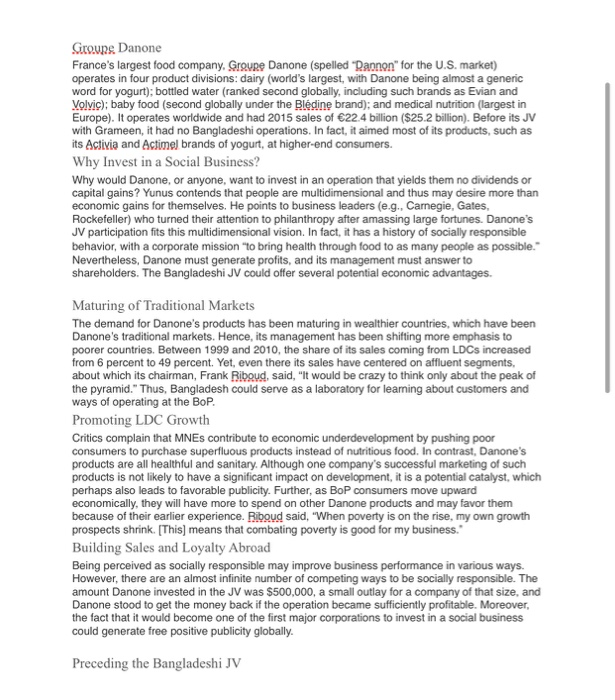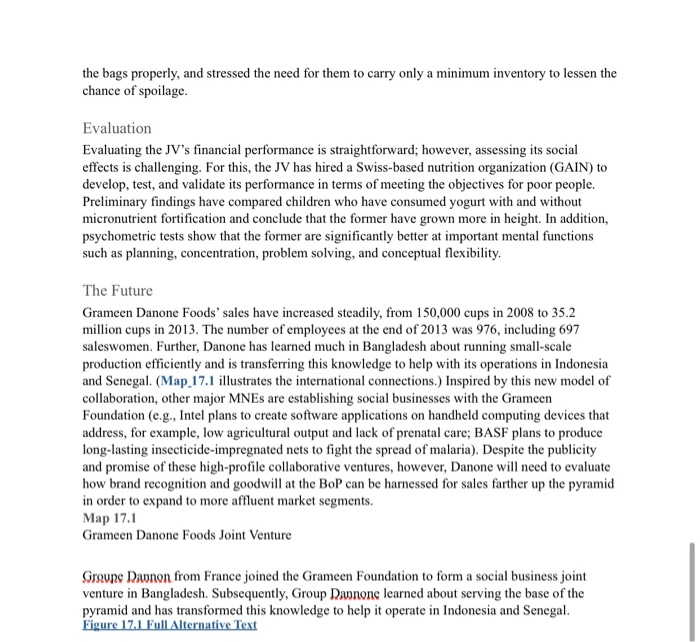below is question and case study
Q2. Since establishment of the Grameen Danone Foods social business, the number of social businesses worldwide has grown so much that there is now an annual global sum- mit in Wolfsburg, Germany. Are there types of companies that might not be good candidates to establish social businesses? If so, what are they and why?
i need answer of this which should be relevant 300 words. no copy paste all other answers on chegg are wrong....




Groupe Danone France's largest food company. Groupe Danone (spelled "Dannon" for the U.S. market) operates in four product divisions: dairy (world's largest, with Danone being almost a generic word for yogurt); bottled water (ranked second globally, including such brands as Evian and Volvi); baby food (second globally under the Bldine brand); and medical nutrition (largest in Europe). It operates worldwide and had 2015 sales of 22.4 billion ( $25.2 billion). Before its JV with Grameen, it had no Bangladeshi operations. In fact, it aimed most of its products, such as its Activia and Actimel brands of yogurt, at higher-end consumers. Why Invest in a Social Business? Why would Danone, or anyone, want to invest in an operation that yields them no dividends or capital gains? Yunus contends that people are multidimensional and thus may desire more than economic gains for themselves. He points to business leaders (e.g., Carnegie, Gates, Rockefeller) who turned their attention to philanthropy after amassing large fortunes. Danone's JV participation fits this multidimensional vision. In fact, it has a history of socially responsible behavior, with a corporate mission "to bring health through food to as many people as possible." Nevertheless, Danone must generate profits, and its management must answer to shareholders. The Bangladeshi JV could offer several potential economic advantages. Maturing of Traditional Markets The demand for Danone's products has been maturing in wealthier countries, which have been Danone's traditional markets. Hence, its management has been shifting more emphasis to poorer countries. Between 1999 and 2010, the share of its sales coming from LDCs increased from 6 percent to 49 percent. Yet, even there its sales have centered on affluent segments, about which its chairman, Frank Riboud, said, "It would be crazy to think only about the peak of the pyramid." Thus, Bangladesh could serve as a laboratory for learning about customers and ways of operating at the BoP. Promoting LDC Growth Critics complain that MNEs contribute to economic underdevelopment by pushing poor consumers to purchase superfluous products instead of nutritious food. In contrast, Danone's products are all healthful and sanitary. Although one company's successful marketing of such products is not likely to have a significant impact on development, it is a potential catalyst, which perhaps also leads to favorable publicity. Further, as BoP consumers move upward economically, they will have more to spend on other Danone products and may favor them because of their earlier experience. Riboud said, "When poverty is on the rise, my own growth prospects shrink. [This] means that combating poverty is good for my business." Building Sales and Loyalty Abroad Being perceived as socially responsible may improve business performance in various ways. However, there are an almost infinite number of competing ways to be socially responsible. The amount Danone invested in the JV was $500,000, a small outlay for a company of that size, and Danone stood to get the money back if the operation became sufficiently profitable. Moreover, the fact that it would become one of the first major corporations to invest in a social business could generate free positive publicity globally. Preceding the Bangladeshi JV At a 2005 lunch in Paris, Biboug asked Yunus what Danone might do to help the poor. When Yunus explained the social business concept, Biboud immediately said, "Let's do it," and the two shook hands on setting up their JV. Although this JV is one of the first social businesses established in partnership with a major MNE, Roosevelt's forgotten man" was not completely forgotten in the interim. Many organizations have marketed to the BoP (most notably in India during the 1970s' heyday of the appropriate technology movement), with such devices as dungpowered stoves. These experiences offer the following lessons for companies wishing to tap the BoP, especially with a nutritious product: - Price - Low and stable prices help create and sustain sales, so companies gain an advantage by finding new means to cut and stabilize their own costs, which they then pass on to customers. - Product compatibility - High nutrition at a low price alone is insufficient. Products must be compatible with the target market's accustomed habits and visually appealing and flavorful to them. So it is vital to pick the right products and adapt them to local markets. - Education - Within some countries the BoP is largely illiterate, has low access to popular media, and is unconvinced about cause-and-effect scientific relationships. Hence, it may be important to reach people in this segment by nontraditional means, convince them that changes from nutrition are important and take time, and convey information that they will believe. - Promotion-Publicity prior to the start of sales is quite valuable, so the use of opinion leaders (those that the target market group accepts) is essential in developing credibility. - Competition - Given efforts to help the poor, competition may come from government programs, not-for-profit organizations, and charities. Thus, companies need to outperform this competition or find means of working cooperatively with it. Strategic Thrust and Orientation After their 2005 Paris handshake, the JV began production in less than two years. The partners started with a small rural factory to serve only its surrounding poverty-stricken area. Given the JV's social objective, the partners agreed that product and production would be as green as possible. Even though the factory is the size of only one percent of Danone's standard factories elsewhere, it has the latest equipment, treatment of both incoming and outgoing water, and solar panels to generate renewable energy. Product Policies The introductory plant and two more built by 2015 make only yogurt, a product of high nutritional value for children. It relies on efficient small-scale production and nearby supplies of the main ingredient (milk). Through market testing, Danone decided to sell a sweeter and thinner yogurt, drinkable directly from the container (subsequent market feedback led the JV to include spoons as well). It fortifies the yogurt with 30 percent of the daily need for vitamin A, zinc, and iodine, and it uses biodegradable technology so that containers can be converted to fertilizer. Pricing To keep costs and prices low, the plant uses mostly local ingredients, mainly from small suppliers such as farmers with only one or two cows, who collect and deliver milk in jugs (thus saving refrigeration and transportation costs). Because of fluctuating milk prices, the JV negotiated longer-term contracts with farmers to better stabilize prices; hence, the JV pays higher than market price sometimes and less at other times. Fixed sales costs are kept low by selling only on commission (about 20 percent to saleswomen and 80 percent to small local stores). To minimize saleswomen's commissions, the company successfully suggested their selling additional products during house-to-house visits. Personnel costs have been kept low since completion of its start-up phase by employing only Bangladeshis. Although the yogurt plant lacks scale economies, its unit costs are equivalent to Danone's larger plants elsewhere. Promotion Most promotion is word of mouth; however, one promotional event was noteworthy. Riboud arranged for the best-known Frenchman in Bangladesh, the soceer star Zivdine Zidane (Zizou), to visit the plant's opening, an event that made large headlines in newspapers throughout the country. While in Bangladesh, Zizou played with youth in the national stadium, signed the cornerstone of the plant, and contributed to instant national recognition for the new JV and its yogurt. Branding The JV name put Grameen first because of its high recognition. The yogurt brand is Shokti Doi, meaning "yogurt for power," and its symbol is a museled lion that appears on the product and in ads. Lion-dressed mascots also visit youth areas to describe the value of eating yogurt. Distribution Bangladesh's high underemployment attracted more than enough women - mainly poor mothers from the target sales market - to work part time selling yogurt. However, the JV had to overcome a backlash similar to the one GB faced when lending to women; the complaint this time was about the impropriety of women going house-to-house. The next big task was to train the saleswomen on (1) the significance of selling yogurt other than to earn a commission and (2) the essentiality of the yogurt's quality and how to maintain it. First, the significance for selling was primarily nourishment. The company engaged doctors who explained that children could regain any physical loss from previously deprived nutrition within 9 to 10 months by consuming only two cups of yogurt per week. Second, selling would help improve the economy by using suppliers who would then hire more people and spend within the community. Maintaining yogurt quality was essential because few homes had refrigeration, and eating a spoiled product could cause illness and future sales losses. The company demonstrated to saleswomen how it makes yogurt, provided them with insulated bags, showed them how to use the bags properly, and stressed the need for them to carry only a minimum inventory to lessen the chance of spoilage. Evaluation Evaluating the JV's financial performance is straightforward; however, assessing its social effects is challenging. For this, the JV has hired a Swiss-based nutrition organization (GAIN) to develop, test, and validate its performance in terms of meeting the objectives for poor people. Preliminary findings have compared children who have consumed yogurt with and without micronutrient fortification and conclude that the former have grown more in height. In addition, psychometric tests show that the former are significantly better at important mental functions such as planning, concentration, problem solving, and conceptual flexibility. The Future Grameen Danone Foods' sales have increased steadily, from 150,000 cups in 2008 to 35.2 million cups in 2013. The number of employees at the end of 2013 was 976 , including 697 saleswomen. Further, Danone has learned much in Bangladesh about running small-scale production efficiently and is transferring this knowledge to help with its operations in Indonesia and Senegal. (Map_17.1 illustrates the international connections.) Inspired by this new model of collaboration, other major MNEs are establishing social businesses with the Grameen Foundation (e.g., Intel plans to create software applications on handheld computing devices that address, for example, low agricultural output and lack of prenatal care; BASF plans to produce long-lasting insecticide-impregnated nets to fight the spread of malaria). Despite the publicity and promise of these high-profile collaborative ventures, however, Danone will need to evaluate how brand recognition and goodwill at the BoP can be harnessed for sales farther up the pyramid in order to expand to more affluent market segments. Map 17.1 Grameen Danone Foods Joint Venture Greupe Dapnon from France joined the Grameen Foundation to form a social business joint venture in Bangladesh. Subsequently, Group Dapnone learned about serving the base of the pyramid and has transformed this knowledge to help it operate in Indonesia and Senegal. Figure 17.1 Full Alternative Text










